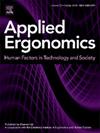在模拟建筑相关任务中评估背部支撑外骨骼:对任务完成时间和可用性方面的影响
IF 3.4
2区 工程技术
Q2 ENGINEERING, INDUSTRIAL
引用次数: 0
摘要
背支撑外骨骼(BSEs)是一种有前途的干预措施,在减少体力需求在不同的职业任务。然而,关于不同疯牛病设计在建筑工作中的有效性以及这些影响在新手和有经验的工人之间是否一致的信息有限。考虑到工人的经验水平,我们评估了施工过程中bse的好处和潜在的意外后果。40名参与者(20名新手和20名有经验的人,两组按性别平衡)完成了几个与建筑相关的实验室模拟任务。这些任务是在控制条件(无BSE)和三种BSE下执行的,每种BSE都在两种支持设置(打开和关闭)中进行测试。使用完成时间测量任务绩效,并获得可用性的各个方面的感知。一般来说,在模拟任务中,使用疯牛病会增加任务完成时间、感知到的不适和感知到的干扰,而对感知到的体力劳动的影响则是混合的。刚性BSE尤其增加了感知到的运动限制,而软性BSE(或外套)则没有。在少数情况下,BSE对完成时间和BSE可用性的影响在新手和有经验的组之间有所不同。虽然在经验水平之间观察到一些差异,但未来的工作可能会关注新手群体,并对具体结果持谨慎态度。总的来说,我们的研究结果表明,BSE对完成时间和可用性感知的影响是明显的,并且是特定于任务的,没有一个单一的BSE设计在模拟任务中表现出明显的优势。本文章由计算机程序翻译,如有差异,请以英文原文为准。
Evaluating back-support exoskeletons in simulated construction-relevant tasks: Effects on task completion time and aspects of usability
Back-support exoskeletons (BSEs) are a promising intervention in reducing physical demands during diverse occupational tasks. However, limited information is available about the effectiveness of different BSE designs during construction work and if those effects are consistent between novices and experienced workers. We evaluated the benefits and potential unintended consequences of BSEs during construction work, considering worker experience levels. Forty participants (20 novices and 20 experienced, balanced in both groups by sex) completed lab-based simulations of several construction-relevant tasks. These tasks were performed under a control condition (no BSE) and with three BSEs, each of which was tested in two support settings (on and off). Task performance was measured using completion time, and perceptions of diverse aspects of usability were obtained. Generally, BSE use increased task completion time, perceived discomfort, and perceived interference of BSEs during simulated tasks, while its effects on perceived physical effort were mixed. Rigid BSEs particularly increased perceived movement restrictions, while a soft BSE (or exosuit) did not. In a few cases, the effects of BSEs on completion time and BSE usability differed between novice and experienced groups. While some differences were observed between experience levels, future work could focus on novice populations with caution regarding specific outcomes. Overall, our results suggested that the effects of BSEs on completion time and perceptions of usability were distinct and task-specific, with no single BSE design emerging as being clearly superior across the simulated tasks.
求助全文
通过发布文献求助,成功后即可免费获取论文全文。
去求助
来源期刊

Applied Ergonomics
工程技术-工程:工业
CiteScore
7.50
自引率
9.40%
发文量
248
审稿时长
53 days
期刊介绍:
Applied Ergonomics is aimed at ergonomists and all those interested in applying ergonomics/human factors in the design, planning and management of technical and social systems at work or leisure. Readership is truly international with subscribers in over 50 countries. Professionals for whom Applied Ergonomics is of interest include: ergonomists, designers, industrial engineers, health and safety specialists, systems engineers, design engineers, organizational psychologists, occupational health specialists and human-computer interaction specialists.
 求助内容:
求助内容: 应助结果提醒方式:
应助结果提醒方式:


